|
The Spoils of War: Finding and Returning Nazi Treasure
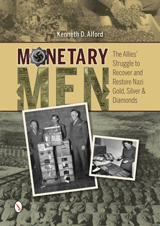 by Kenneth Alford by Kenneth Alford
Posted April 2016

Note: Kenneth Alford is the world’s foremost writer of Nazi treasure stories. He has spent more than 30 years researching archival material relating to the looting of art, gold and other treasures. His books include: Monetary Men, American Crimes and the Liberation of Paris, Sacking Aladdin’s Cave, Hermann Göring and the Nazi Art Collection, Civil War Museum Treasures, Allied Looting in World War II, Nazi Millionaires, Nazi Plunder and The Spoils of World War II. He is a frequent consultant for television productions around the world, and his first book, Spoils of World War II, was the subject of a History Channel documentary. His work has often uncovered lost treasures and helped to re-unite items with their rightful owners.
|
His views are multi-dimensional in that he not only investigates the original plundering but also what happened subsequently at the end of the war—in many cases resulting in a second round of plundering and looting by certain Allied servicemen and women. The stories often start in the 1930s and do not conclude until the modern day.
The following are excerpts from his books.
|
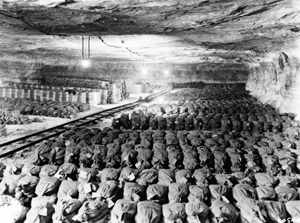
|
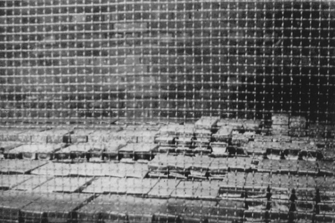
|
|
Long rows of bags filled with gold coins found in the Merkers salt mine. Hundreds of boxes of currency are stacked to the left rear.
|
Bars of gold hidden by the Berlin Reichsbank in the Merkers mine in wire cages, safefrom Allied bombing.
|
During World War II, Nazi treasures recovered by the U.S. Army were delivered to the Foreign Exchange Depository located in Frankfurt, Germany. The first shipment to arrive was the Third Reich gold reserves taken from the salt mine in Merkers. This hoard consisted of gold bullion, gold and silver coins, platinum, jewelry and a large quantity of SS loot in bags, boxes, and parcels. Seventy-five additional shipments were received at the Depository during the remainder of 1945. They came mainly from the U.S. Zone of Occupation in Germany, but some shipments were from Austria, Czechoslovakia and other areas occupied by the U.S. Army. By the end of 1945, the Depository contained the largest single collection of wealth in the world—the gold holding alone was only second to that at Fort Knox.
Deposited in the Foreign Exchange Depository as shipment 16 were the valuables from Buchenwald Concentration Camp. On April 28, 1945, Major Howard M. McBee traveled to the camp to investigate the atrocities and brutal treatment of the prisoners. Two German political prisoners told Major McBee that a large deposit of valuable property was hidden in a cave at the stone quarry in the western part of the camp.
Twenty men went to the quarry and began excavating. After three hours of difficult digging, they gained entrance into the tunnels. When all was completed, the retrieved valuables filled nine two-and-one-half ton army trucks. After clearing out the tunnels, U.S. Army engineers blasted the entrances closed. A bulldozer finished covering the opening with rocks so no one would be injured should the tunnels ever cave in.
|
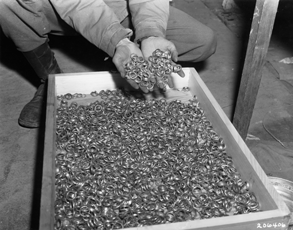
|
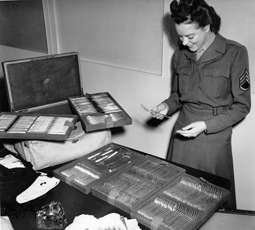
|
|
A few of the thousands of wedding rings taken from the prisoners of the Buchenwald Concentration Camp.
|
Staff Sgt. Virginia Wood examines Eva Braun’s 18th c., 156-piece silver set valued in 1945 at $300,000. Decorated with a Polish coat of arms, it was stolen from the Hapsburg Family.
|
Valuable gems were separated and were placed under the command of the finance officer. The contents were astonishing: an estimated 17,102 pounds of tableware, 4,030 pounds of coins, 7,811 pounds of alarm clocks, and sadly, 134 pounds of children’s toys. Many items were identifiable as to the owners, such as a marriage certificate, passports, bank statements, bank books, graduation certificates and many Hungarian life insurance policies. It appears the Foreign Exchange Depository made an earnest attempt to return the identifiable objects from Buchenwald to the country of origin.
Shipment 76 contained some of the personal items of Mrs. Adolf Hitler, the name his young mistress Eva Braun held less than 48 hours due to her suicide pact with the Führer. Based on the undercover work of U.S. Seventh Army investigators, recovered were her personal items: photographs, motion pictures depicting the life of Eva and Hitler, stamp collections, and the suit worn by Hitler during the attack on his life on July 20, 1944.
One of greatest robberies by U.S. Army servicemen of all times was the theft of the Hesse Crown jewels, stolen after World War II from the Kronberg Castle northwest of Frankfurt by Major David Watson, Colonel Jack Durant and his lover Captain Kathleen Nash.
The Kronberg Castle was requisitioned as a country club for U.S. Army officers, and Captain Kathleen Nash was appointed hostess of the officers’ club. In November 1945 while exploring the castle, Nash and her staff stumbled upon a wooden box full of individually brown-paper-wrapped packages containing millions of dollars’ worth of valuables. Watson, Durant and Nash removed diamonds and other gems from settings by pushing them or cutting them loose from tiaras, necklaces and bracelets found in the packages, and then they sold the gold settings in Switzerland.
|
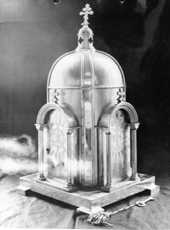
|
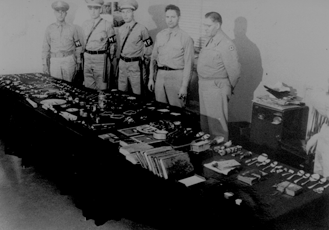
|
|
Looted from the Russian Orthodox Church in Prague, this miniature church of irreplaceable value and exquisite workmanship stood about three feet tall.
|
U.S. Army exhibiting the plunder in Kathleen Nash’s sister’s attic. Asked how much she mailed to her, Nashsaid: “…about one-half, I mean the small stuff.”
|
In January 1946, after the three looters returned to the U.S. with the bulk of the valuables, a member of the Hesse Family, owners of Kronberg Castle, reported the missing jewels to the U.S. Army. Investigations by the Army's Criminal Intelligence Division determined the magnitude of the thefts, and Watson, Durant and Nash were thereafter arrested. The three were tried in Germany and sentenced to light prison terms. The trials were completed in the spring of 1947.
The Army relentlessly attempted to recover the jewels. Half of them were recovered at the home of Nash's sister. After a further search, the remaining bulk was traced to underground criminal elements in Chicago. Understandably, these larger and more valuable precious stones were never recovered.
|
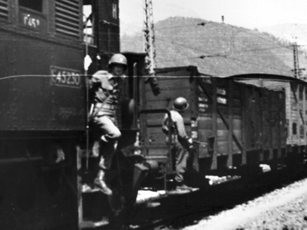
|
The Hungarian Gold Train on a side track at Werfen, Austria, guarded by American soldiers.
|
The most provocative treasure uncovered by my research was the fate of the Hungarian Gold Train, seized by the U.S. Army in 1945. The Presidential Advisory Commission on Holocaust Assets visited me and copied thousands of pages from my personal library. In 1998, this commission found there was “…documentary evidence that American Forces in Austria misappropriated so-called unidentifiable property of Hungarian Jews found on the Gold Train.”
On May 7, 2001, the law firm of Cuneo Waldman & Gilbert filed a class-action suit in the United States District Court, Miami, on behalf of Hungarian Holocaust survivors and their heirs. On September 30, 2005, after more than four years of hard-fought litigation, the Hungarian Gold Train lawsuit was finally concluded successfully. The United States District Court gave its final approval to the proposed settlement of $25.5 million paid into the settlement fund. This fund was allocated to pay for social welfare benefits to financially needy Hungarian Holocaust survivors.
On January 31, 2006, the lead counsel wrote: “There is little question that this whole sorry episode would never have come to light had you [Kenneth D. Alford] not unearthed it. For that and for your generosity in sharing with us your time, your expertise and insights, and your files, I want to express deep gratitude on behalf of the lawyers and plaintiffs. You should be extremely proud of your role in helping to right this historic wrong.”
|
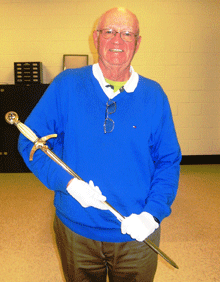
|
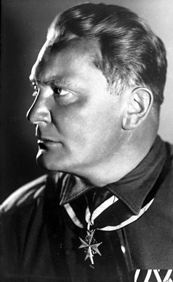
|
|
Alford (here) also tracked the Allied looting of Reichsmarschall Hermann Göring’s “wearing” wedding sword. Last purchased for $2 million, itwas seized by U.S. Marshals in a 1997 drug arrest.
|
Hermann Göring
(Photo: Bundesarchiv, Bild 102-13805.)
|
A Synopsis of Monetary Men:
In the closing days of World War II, the U.S. Government took into custody 370 tons of gold from Nazi Germany, but the gold, silver, and currency still missing is even greater. Author Ken Alford traces the recovery of more than 500 of these large caches by the Allies and then their mysterious disbursement. Among their finds, the Monetary Men of the U.S. Army uncovered 288 tons of gold, with hordes of silver, diamonds, and precious jewels in a salt mine in Merkers, Germany. They took in Holocaust valuables from Dachau and Buchenwald, Ustasha Croatian gold and Italian Fascist gold. An appendix contains a timeline and summaries of all the shipments recovered by the U.S., as well as a financial spreadsheet detailing the 370 tons of gold recovered and its final distribution.
Monetary Men by Ken Alford may be purchase at www.schifferbooks.com
for $29.99.
|